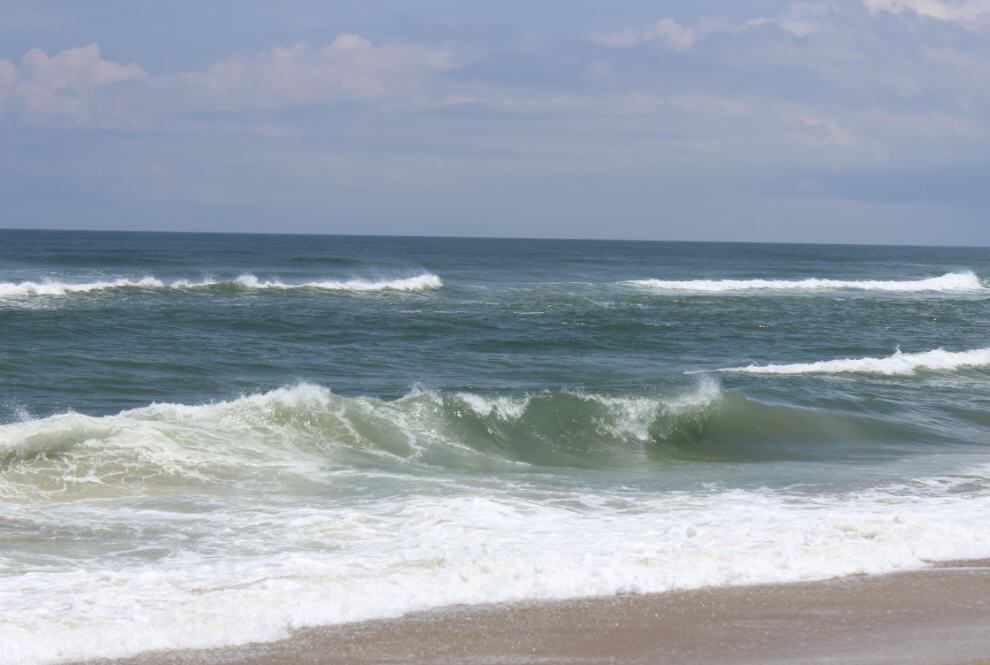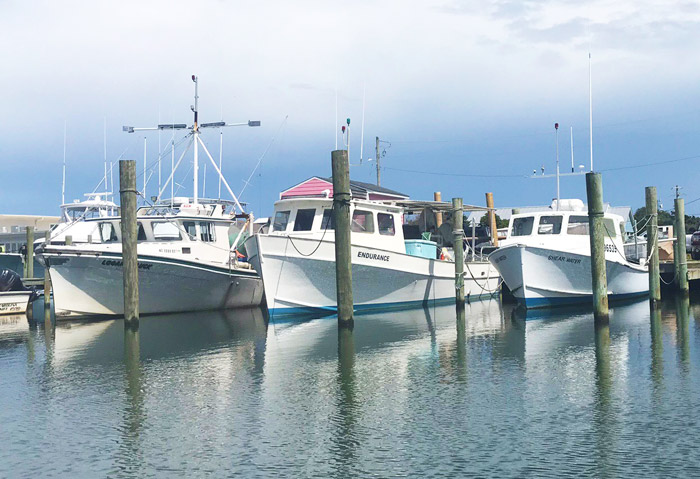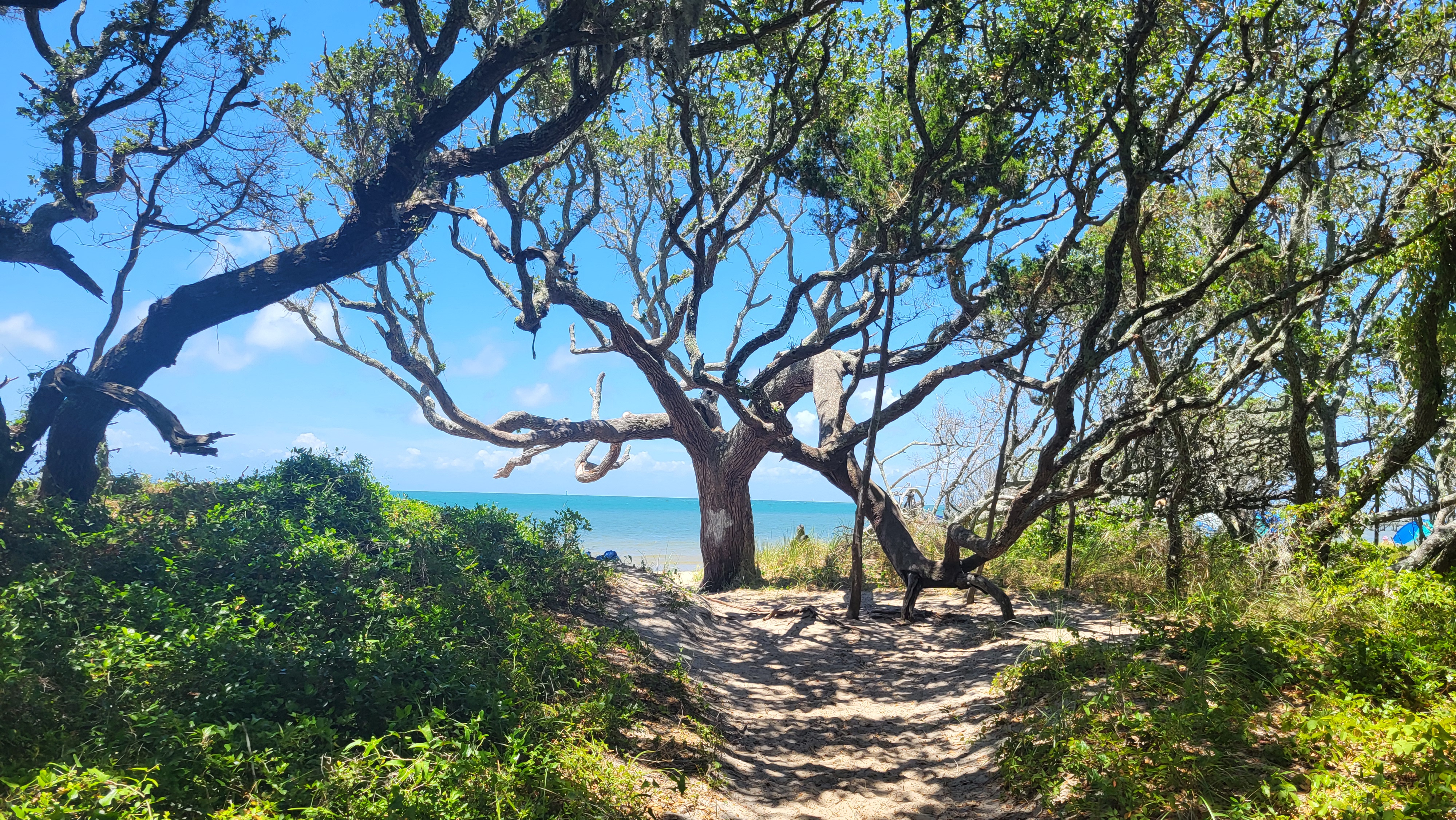Sand Tiger Sharks Call NC Shipwrecks Home
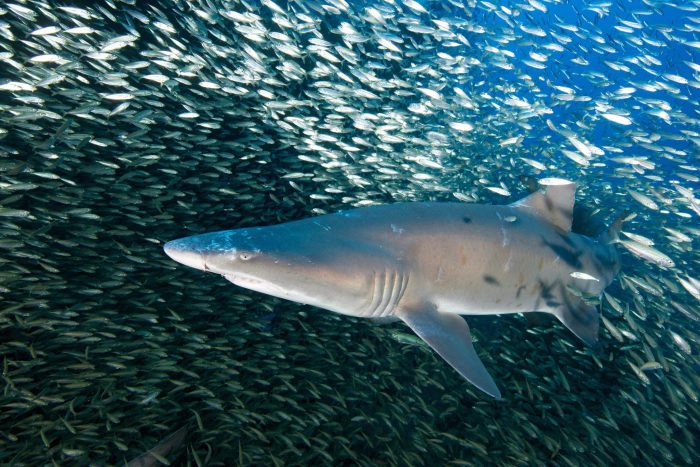
The word “shark” conjures fear in many people, but these important large predators serve a critical role in the ecosystems in which they live.
Most sharks do not pose a threat toward people who venture into their domain. In fact, the sand tiger shark is one reason why so many scuba divers from across the world visit North Carolina’s “Graveyard of The Atlantic” – to dive with and photograph these magnificent animals that call the region’s shipwrecks their home.
National Oceanic Atmospheric Administration marine ecologists and their colleagues from the North Carolina Aquariums and South-East Zoo Alliance for Reproduction and Conservation sent remotely operated vehicles, or ROVs, to study and videotape how sand tiger shark presence related to reef fish on six Atlantic shipwrecks.
“We found that where the sand tiger sharks were present there was a higher variety of reef fish present that created a halo effect surrounding the sharks,” said National Oceanic and Atmospheric Administration ecologist Avery Paxton.
“Slowly cruising sand tiger sharks can act as a predation refugia, a large structure to hide behind during major predation periods on the reef. We filmed and observed mackerel scad schooling in close to sand tigers when we first dove the (wreck of the) USS Tarpon, we observed this association to change depending on time of day,” said Richard Gilmore Jr., senior scientist with Estuarine, Coastal and Ocean Science Inc. and a noted shark researcher. “We put our ROV on the bottom adjacent to the wreck for nearly an entire day at a time and watched the change in sand tiger behavior and the fish associated with them, actually surrounding the shark body until an hour or two after sunset.”
“We could do this as we used SIT (Silicon Intensified Cameras) on our Super Phantom ROV. The SIT cameras were special low-illumination cameras that allow viewing underwater during extreme low-light periods. There is no color, but you can see sand tiger behavior clearly at depths of 150 feet in clear water up to 60-90 minutes after sunset before astronomical twilight,” Gilmore said.
“What we discovered was that the mackerel scad would move closer to the shark as the sun set. There is higher predation during the crepuscular (twilight) period. We also actually filmed little tunny and common amberjack diving through the scad around sunset and afterwards. This is a typical period for densely schooling prey species to seek shelter on a reef or shallower nearshore waters where predators cannot get below them,” he said.
Gilmore said the scad were clearly using sand tiger sharks as a refuge from predators.
“We actually filmed the scad leaving the wreck and swimming up around the sand tiger’s body as the shark neared the wreck, then leaving the shark as it swam away from the wreck,” he said.
New research has shown that sand tiger sharks actually invoke changes to local fish species that are found on these same shipwrecks.
“We saw a lot of midwater-column species, including large jacks, barracuda and small silvery fish, hanging around the sharks. We discovered that sand tiger sharks play an important ecological role on shipwrecks by impacting the variety of reef fish seen at the same time,” Paxton said.
“On wrecks where there were no sharks, we saw a higher number of bottom-dwelling species, such as grouper and sea bass,” she said.
“Unlike other sharks, the sand tiger shark is holding sentinel over these shipwrecks off North Carolina. It surprised me how dramatically the reef fish species varied on wrecks when the sharks were not there,” said NOAA ecologist Chris Taylor.
Sand tigers are the top predator that balances the flora and fauna of the reef, analogous to the wolves of Yellowstone controlling elk populations or in Canada “keeping the caribou strong” as the Inuit say, or lions on the Serengetti controlling antelope and hyena populations, Gilmore said.
“Our team’s research has shown sand tiger sharks are important to maintain a diversity of species on shipwrecks,” said Paxton. “They create a fascinating ecological mix of small, large and colorful species of fish all over the wrecks, making the shipwrecks an oasis for marine life.”
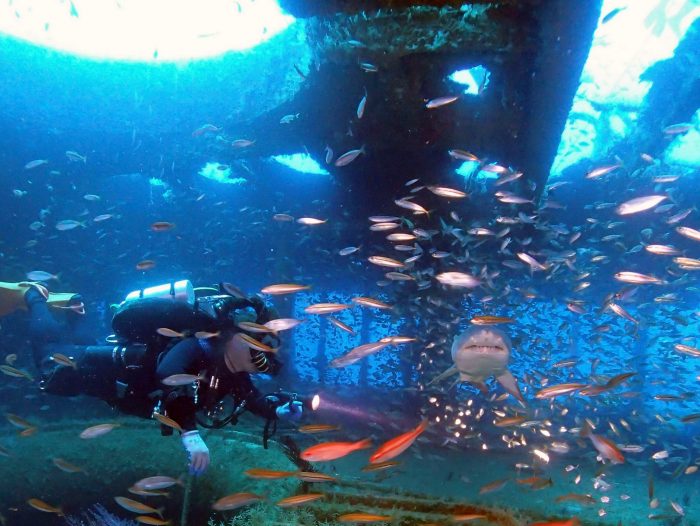
The Lore of Diving with Sand Tiger Sharks
Divers from across the world have been visiting North Carolina for more than 40 years for the plethora of shipwrecks found off the state’s coast, but for many, it is the sand tiger sharks seen on the same wrecks year after year that lure them.
“North Carolina was a destination I and a couple of my buddies wanted to visit for the last two years. It is within driving distance from Massachusetts and Connecticut and is what we would consider warm-water diving. Wrecks and sharks in the Morehead City area were the two big attractions we came to see,” said Massachusetts diver Denis Erofeyev.
“We got to see younger and faster sand tiger sharks inside some of the wrecks, such as the Aeolus, and much larger ones outside of the wreck of Caribsea. At the Caribsea, we swam inside with a group of 10 to 12 sharks that were all 6 to 7 feet long,” he said. “I didn’t do a whole lot of research on the species before the trip, so I was just excited to see sharks I haven’t seen before. During a two-hour ride to our first dive at the Aeolus, other divers told us about the ‘shark room’ and sharks swimming right at you in the corridors, which was exactly what happened, and I was thrilled to be in the water with them. I was amazed how unafraid they are of the humans. I would go there again to get more time in the water with them,” said Erofeyev.
“However, if Denis decided to touch one of them as one of our photographers did, he would experience a bite reflex that aquarists know well. It may be painful,” Gilmore said.
Sand tiger sharks do not get spooked or show much interest in divers, “but they know you are there,” said technical diver, Michael MacDonald.
They are docile until you touch one, he added.
“Sand tiger sharks make excellent photography subjects since they are not spooked easily. I just enjoy watching them and you can often get very close to them. They often swim with their mouths open and you can get really nice shots of them with their mouth and rows of teeth exposed,” he said.
Long-term observations that continued into the night helped researchers conclude that sand tiger sharks are active nocturnal feeders and mate at night. The hypothesis is supported by observations by commercial fishermen, ROV recordings that showed increased swimming speeds — sharks chasing sharks — after sunset and increased incidence of mating scars on the same individual after a night between filming periods.
“Males are as scared as females as this is the only shark that I know of that keeps males at bay until they want to mate, and they all mate on the same night. The Sidney Aquarium observations from decades ago indicated that there was an alpha male that mated first,” Gilmore explained.
The large presence of wrecks off the North Carolina coast make for a fantastic dive destination, MacDonald said.
“A large amount of the wrecks are World War II-era and many have a history attached to them. While I prefer natural wrecks, North Carolina has also sunken many artificial wrecks (the Aeolus and Spar). These wrecks are teaming with marine life, huge bait balls and often large schools of sand tiger sharks, said MacDonald. “I firmly believe that when the conditions in North Carolina are good, it is some of the best diving in the United States.”
MacDonald said he usually visits North Carolina in late May to early June, when the water is still relatively cold by North Carolina standards but comfortable compared to New England waters and visibility is 50-60 feet on the offshore wrecks.
“While May can sometimes be early for sand tigers, we have always had pretty good luck,” he said.
On one trip in late May 2013 he said there must have been more than 100 sand tiger sharks on the Spar. It was a memorable experience seeing a wall of sharks, he said.
In 2018, while diving at the Papoose, there was a similar experience with 30 to 50 or more sand tiger sharks along with dusky and bull sharks, he said.
Generally, May through October is the best time to see sand tigers off North Carolina. June and July are also good. Later in the summer and early fall can also yield results but being peak hurricane season, divers are more likely to miss days of diving due to weather. By late June, the Gulf Stream has moved closer to shore and visibility can often be 70-100 feet or more on a lot of the offshore wrecks, MacDonald said.
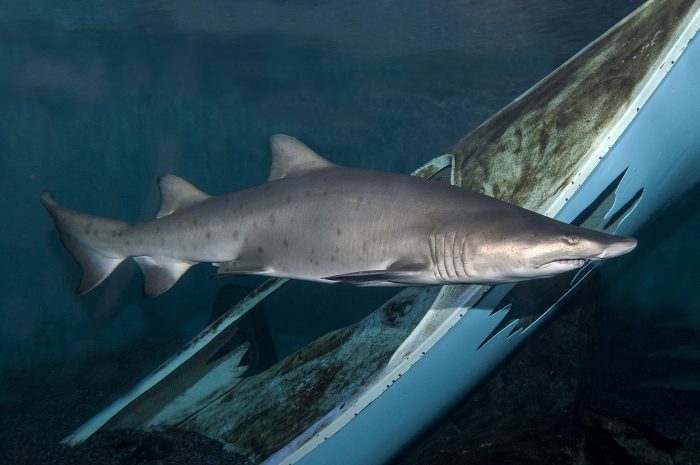
Sand Tiger Shark Biology
Sand tiger sharks are found in all warm-temperate and temperate waters throughout the world. The sand tiger shark does not occur in the tropics. It does not occur in estuaries south of Cape Hatteras as adults, only to the north in the Chesapeake, Delaware and Narragansett bays.
In North Carolina, It’s long been known that there was a southern migration of sand tigers from waters north of Cape Hatteras. “However, our studies showed that it was the male sand tigers that migrated to North Carolina wrecks south of Cape Hatteras, all the way to east Florida to mate during the winter. The females never migrated,” said Gilmore. “We had groups of females that we sampled all year off east central Florida in the same area.”
Sand tigers are bulky in appearance with a flattened round, pointed snout. Their eyes are small and do not have eyelids. They have three erect functional rows of narrow anterior upper and lower jaw teeth used to grasp and swallow prey, not to cut or attack anything they could not swallow.
Sand tiger teeth are distinct in that the sand tiger can only consume small prey. It cannot cut prey with flat, serrated upper jaw teeth as seen in bull, sandbar, dusky and other common sharks.
Also, sand tigers will surface and gulp air to help balance their buoyancy.
“This species is usually harmless toward humans during regular daytime activities, but at night, sand tiger sharks become aggressive predators and have been known to attack a diver’s video light or dive light, apparently mistaking dive lights for the bioluminescent trail of a fleeing fish,” Gilmore said.
“Many nocturnal predators key on and chase “biological light,” produced by swimming fish disturbing microscopic plankton that produce light when disturbed, like aquatic fireflies. This is bioluminescence. But they certainly do like to feed voraciously in groups at night. Ask the croaker and net fishermen off Hatteras,” he said.
Sand tigers have two dorsal fins that are just about the same size. Nurse and lemon sharks both share this trait and are also found off North Carolina, but other than the dorsal fin similarity, nurse and lemon sharks look nothing like sand tiger sharks. The fin structure and body shape of the sand tiger makes them very easy to identify. Sand tigers have a distinctive “hump” on their backs that no other shark in local waters will feature.
Sexual maturity for males is reached when the shark is about 6 feet in length, or 6-7 years of age. Females mature when they grow to about 7 feet in length or reach 9-10 years old. Females give birth to a single pup from each of two uteri, who will devour their siblings in utero.
“They are the only shark species known to do this. They also feed on unfertilized eggs until a month of two before birth. All the lamnoid sharks (makos, great whites, threshers) feed on uterine eggs. We call this oophagy. Most sharks do not reproduce this way. Many reproduce like us, with a placenta and nourishment directly from the mother through the uterine membrane. Bull sharks have a little belly button when born where the placenta had attached. However, there was not doctor to tie it off, it closed and healed naturally,” Gilmore said.
“Mating is thought to take place between late March and April, with an average litter of two pups one from each uterus,” said Kate Goggin, a NOAA representative.
Female sand tiger sharks captured south of Cape Hatteras in studies were always pregnant if they were mature females resident in permanent spawning populations between June and November, Gilmore said.
“Every year males would show up on the North Carolina wrecks during the winter and spring and be lacerated by females and females lacerated by males. These were the obvious mating scars observed every year. No other shark that we know of shows mating scars on males. The sand tiger always does. These scars can heal within a month or two. We have documented that. They heal very quickly. You have to be there when they are mating,“ Gilmore said.
Catching Sand Tigers Prohibited by Federal Law
It is illegal to harvest a sand tiger shark. NOAA says, “If you don’t know, let it go.” This refers to sand tiger sharks and several other commonly encountered but prohibited shark species found in the U.S. Atlantic, Gulf of Mexico and Caribbean. The list includes great white, dusky, bigeye thresher, sand tiger and longfin mako, to name but a few.
NOAA suggests practicing the following safe catch-and-release practices if you happen to hook a shark:
- To maximize survival, keep the shark in the water. Use heavy fishing tackle to minimize the amount of time you spend fighting the shark. This will increase the shark’s chances of surviving the encounter.
- Do not gaff a shark that you plan on letting go. Use the leader to hold the shark at boat-side with its head underwater facing into the current.
- Remove hooks by using a dehooking tool. If you cannot remove the hook, or if removing it would cause harm to either you or the animal, cut the leader as close to the hook as safety allows to minimize any and all training gear that could adversely impact the shark once released. You can also use bolt cutters and remove the hook itself.
- When releasing the shark, let water flow through its gill slits by moving the animal forward in the water, or by placing the shark so the current flows toward its head until its energy returns.
Citizen Scientists Wanted
Spot a Shark USA is a citizen science program led by the North Carolina Aquariums to engage divers in sand tiger shark research and conservation. Photos of sharks you submit to SpotASharkUSA.com help solve mysteries about these imperiled sharks.
How do you photograph a shark for this project? Position yourself at a right angle either the left or right side of the shark, being careful to not block or alter the sharks behavior swimming through the water column.
The North Carolina Aquariums ask that you try to include the entire side of the sand tiger shark in your photos. Make sure your best photos are submitted that clearly show the sharks spots and markings including scars on the animal.
If you find yourself in a school of sand tigers, focus your attention on one animal at a time and do not try for super-wide-angle photos, but rather get single shark side-view images that show the body markings clearly.
Here’s how the project works: Photograph individual sand tiger sharks, post your images on SpotASharkUSA.com, where researchers will then try to identify each animal.
This is your opportunity as citizen scientists and avid lovers of the sea to make a difference and help protect and conserve the magnificent sand tiger shark.


